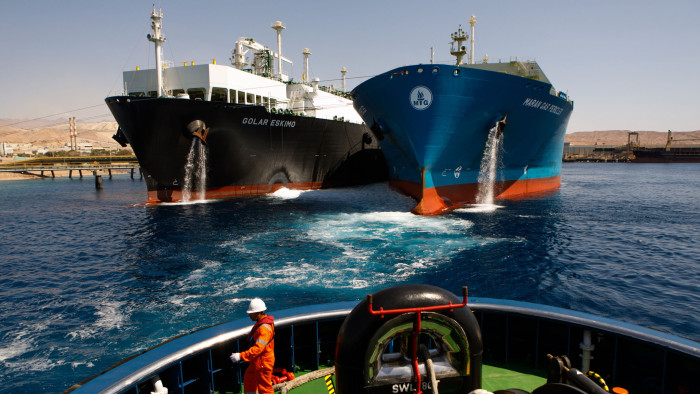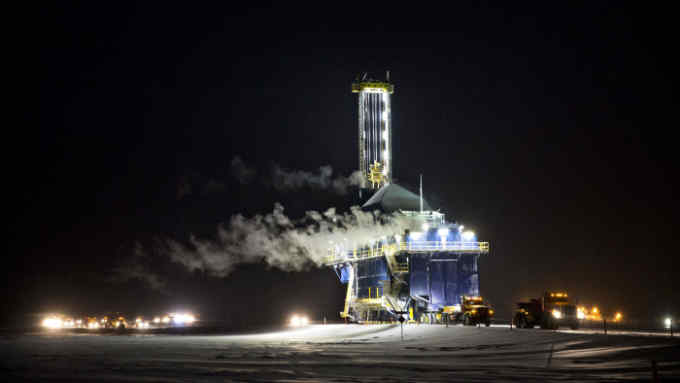It looks like a ship, floats like a ship . . . but it’s an LNG plant

Simply sign up to the Oil & Gas industry myFT Digest -- delivered directly to your inbox.
When shale drilling flipped the US from a country short of natural gas to being the world’s largest producer, coastal terminals built at a cost of billions of dollars to receive imports were suddenly white elephants.
When Egypt managed to boost its domestic gas production, reducing its reliance on imported cargoes of the supercooled fuel, the transition was easier: the main infrastructure simply left.
That is because Egypt was using floating storage and regasification units, or FSRUs. The FSRU is a type of tanker fitted with equipment to gently warm liquefied natural gas (LNG) back into a gaseous state so it can be piped to customers on land.
The first FSRU was launched in 2005. Today the fleet consists of 35 vessels, according to IHS Markit. More than 100 import projects that will use FSRUs are in the works, says the consultancy.
The FSRU is cheaper and faster to install than an onshore regasification plant. If a country’s situation changes the owner can unmoor an FSRU and motor to a more favourable destination or use it in the interim as an LNG carrier.
That was the case in Ghana in 2017. After months of waiting for a pipeline, jetty and breakwater, FSRU owner Golar LNG raised anchor in 2017 and took it elsewhere, securities filings show. As of early November the vessel was in the south Atlantic ocean, according to Refinitiv.
“If something happens in this relatively unstable world, you can sail away,” said Sveinung Støhle, chief executive of Höegh LNG, a Bermuda company with a fleet of 10 units.
Natural gas markets were once limited by the continental reach of pipelines. LNG condenses gas into a cargo valuable enough to pay the freight for a ship. But then LNG must be turned back into a gas.
An onshore regasification terminal can cost $500m-$1bn and take four years to construct, according to the International Finance Corporation, a sister organisation of the World Bank. The infrastructure necessary to offload an FSRU costs $80m-$200m and can be operational in less than two years. The vessels themselves are built in shipyards and leased from shipowners to customers.
“The classical way [of buying LNG] was to build a large land-based facility, with lots of concrete and steel, that [would] take five or six years to complete. We have basically disrupted that market by putting that same equipment on something that floats, that looks like a ship, that is actually a ship,” Mr Støhle said.
FSRUs take LNG from long-distance carriers and warm it up with seawater or the heat from burning some of the gas.
Onshore plants have advantages: they are permanent, can store more gas and offer customers such as utilities and power plants greater supply security. FSRUs handle less volume and lack significant storage.
Today FSRUs account for more than a tenth of world regasification capacity of 780m tonnes a year, according to Jason DuPaul, an IHS Markit senior LNG analyst. Since 2014 Lithuania, Egypt, Jordan, Pakistan, Colombia and Bangladesh have all made their first LNG imports via FSRUs, avoiding “longer and more expensive building processes for onshore terminals”, points out Mr DuPaul.
The number of importing markets entirely dependent on FSRUs is expected to more than double to 14 next year compared with five years ago, according to data compiled by IHS Markit and the International Gas Union. But developing countries are not the only ones taking gas from FSRUs. Excelerate Energy, a US company, moors FSRUs off Boston to meet demand in winter that seasonally overwhelms the pipelines leading from American shale gasfields.
Australia, better known as an LNG exporter through megaprojects on its north-west coast, has signed two deals with Höegh to bring FSRUs to serve the populous south-east after supplies there fell short.
“Everybody said I was crazy,” Mr Støhle said. But given the thousands of kilometres that separate Australia’s gasfields and its big metropolitan areas, it made “perfect sense”.

Comments